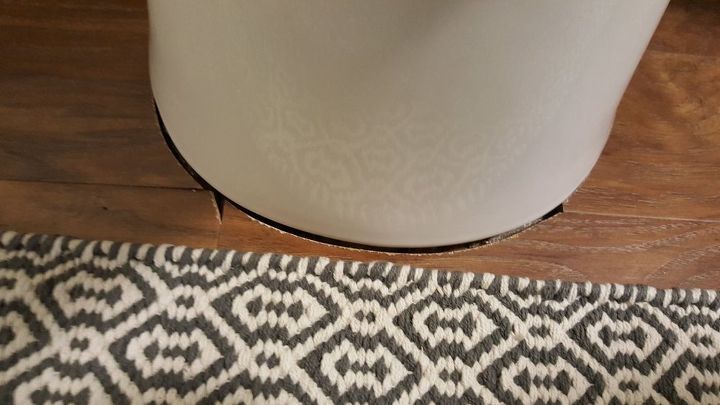Placing laminate on a crooked floor

Anyhow, at the center of the room the floor tilts downwards a little bit, like a crater. We haven't measured how much yet, but I would guess it is a few cm.
Anyone have any suggestions on what we can do to even it up? The easiest way is preferable, of course.
-
Are you taking the ugly floor out?Do you have concrete or wood underneath?
 Janet Pizaro
on Aug 20, 2015
Helpful Reply
Janet Pizaro
on Aug 20, 2015
Helpful Reply -
-
a sagging floor could indicate that you need to look at you foundations...and if it is the flooring already there then pull it up.
 Terry
on Aug 20, 2015
Helpful Reply
Terry
on Aug 20, 2015
Helpful Reply -
-
Have a similar problem on both wooden strip and concrete floor Hope someone can hep
 Dorothy Matthews
on Aug 21, 2015
Helpful Reply
Dorothy Matthews
on Aug 21, 2015
Helpful Reply -
-
First check to make sure there isn't foundation issues or floorboard stringer issues. If after addressing any structural issues, you find that the floor is still not level you will need to put down a leveling agent and then install new luan before installing the laminate.
 LD
on Aug 21, 2015
Helpful Reply
LD
on Aug 21, 2015
Helpful Reply -
-
The best solution that I can come up with that is also the cheapest is to get some "self-leveling concrete" and pour it over the area of the floor where the dip is and be sure to feather it out until it's even around all the edges around it. This will level the floor out, however it will NOT fix whatever CAUSED the dip in the first place. There could be a problem with the sub-floor, such as a termite infestation that would cause that portion of the floor to need to be cut out and be replaced. There also could be a problem with the floor joists underneath the floor, such as a cracked or broken joist which would need to be braced or replaced in order to keep your floor from falling completely through. I would recommend that before you pour the concrete that you check the sub-floor and joists first to be on the safe side, because the last thing you or anyone wants is for you or anyone in your family to end up hurt and your home destroyed because you did not take this simple step first. Good luck to you!! :-)
 Jennie Herrick
on Aug 21, 2015
Helpful Reply
Jennie Herrick
on Aug 21, 2015
Helpful Reply -
-
self leveling concrete??
 Carolyn rogers
on Aug 21, 2015
Helpful Reply
Carolyn rogers
on Aug 21, 2015
Helpful Reply -
-
I don't think I'd use self-leveling concrete unless it's a concrete floor to begin with, and even then you would probably have to strip the vinyl to get good adhesion. Check out the other self-leveling options at your hardware store, though. There are some that are more akin to plaster, and I have used them over vinyl, especially when the covering is going to be laminate, which is very good at hiding imperfections.
 Cathy Soukup
on Aug 21, 2015
Helpful Reply
Cathy Soukup
on Aug 21, 2015
Helpful Reply -
-
If there are no foundation issues you can use self-leveling stuff...it works just fine...used it when I put down laminate a few years ago. Just pulled it up to put down hardwood and did not have to do anything as the subfloor remained level where it was patched.
 Terry
on Aug 21, 2015
Helpful Reply
Terry
on Aug 21, 2015
Helpful Reply -
-
Just make sure your vinyl has no abestos before removing it. The floor itself could have it, as well as the glue. If a corner of the vinyl sheet comes up and there is a thin, dry, fibrous, greyish ''underpad'', that could be asbestos too...Sometimes the only option other than abatement is to go over it...As long as it is not disturbed, it is usually considered safe.
 B. Enne
on Aug 22, 2015
Helpful Reply
B. Enne
on Aug 22, 2015
Helpful Reply -
Related Discussions
How to get rid of mice?
We seem to have some unwelcome Mickeys and Minnies in our house. What is the best way to get rid of them?
How to remove popcorn ceiling with asbestos?
I want to remove my popcorn ceiling, but it has asbestos in it. How do I go about this safely?
How to caulk baseboard gaps?
How do I fill gaps at baseboard, should I caulk? If so, does anyone know how to caulk baseboards?
How to fix squeaky hardwood floors?
How do I fix squeaky hardwood floors?
Tile backsplash when there is existing countertop backsplash
We are thinking about how to add a backsplash to our kitchen. Unfortunately when we had our countertops installed we ordered a small backsplash that comes part way up... See more
Contractor mis-cut the floor when he put in the toilet
Hello, Our contractor didn't "measure twice, cut once" when he put in our toilet. Check out the photo. I'd appreciate any suggestions on a fix or a way to hide this m... See more





